Global Food Packaging Market is estimated to be worth USD 352.4 Billion in 2022 and is projected to grow at a CAGR of 4.3% between 2023 to 2032. The study has considered the base year as 2022, which estimates the market size of market and the forecast period is 2023 to 2032. The report analyzes and forecasts the market size, in terms of value (USD Billion), for the market. The report segments the market and forecasts it by type, by material, by application and region/country.
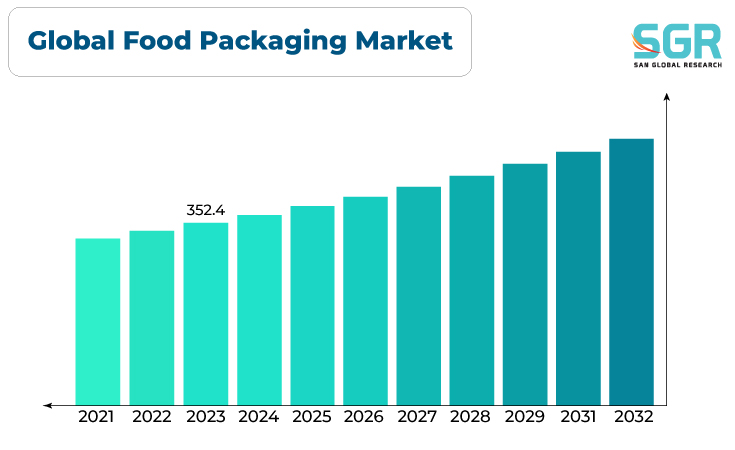
The global food packaging market serves as a vital facet within the larger framework of the food industry, encompassing a diverse array of materials, technologies, and designs aimed at preserving and delivering food products efficiently. With an ever-growing demand for convenient, sustainable, and safe packaging solutions, this market has witnessed continuous evolution and innovation. Key factors propelling its growth include changing consumer lifestyles, increasing urbanization, and a heightened focus on food safety and shelf-life extension. The industry has seen a shift towards eco-friendly packaging materials and designs, spurred by rising environmental consciousness. Innovations such as smart packaging incorporating IoT (Internet of Things) elements for monitoring freshness, antimicrobial coatings, and recyclable or biodegradable materials have gained significant traction. Additionally, stringent regulations aimed at enhancing food safety standards and reducing waste further steer the industry towards sustainable practices. As the global population continues to expand, the food packaging market remains integral in ensuring the integrity, quality, and accessibility of food products while addressing environmental concerns and meeting evolving consumer preferences.
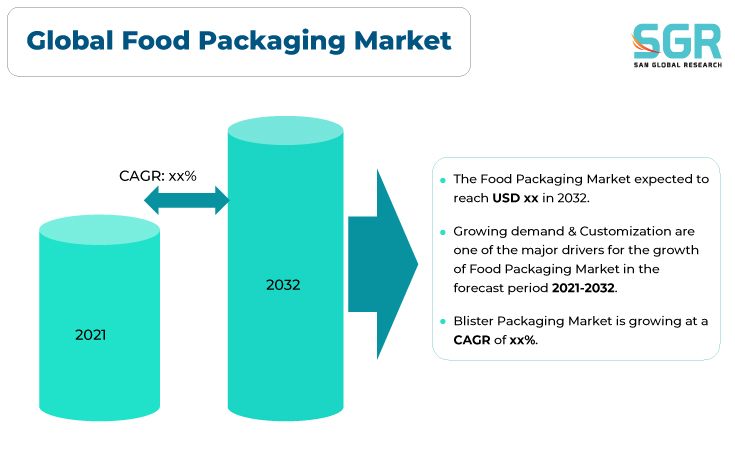
Region Wise Comparison:
Known for its emphasis on sustainability and technological innovation, the North American food packaging market has been gradually shifting towards eco-friendly and recyclable materials. The demand for convenience packaging and ready-to-eat meals has been on the rise due to busy lifestyles. Additionally, there's a growing focus on reducing food waste, leading to developments in intelligent packaging solutions.
Europe has been at the forefront of sustainable packaging practices, with stringent regulations promoting the use of recyclable and biodegradable materials. This continent places a strong emphasis on reducing single-use plastics, which has led to increased adoption of alternatives such as paper-based packaging, compostable plastics, and reusable packaging options.
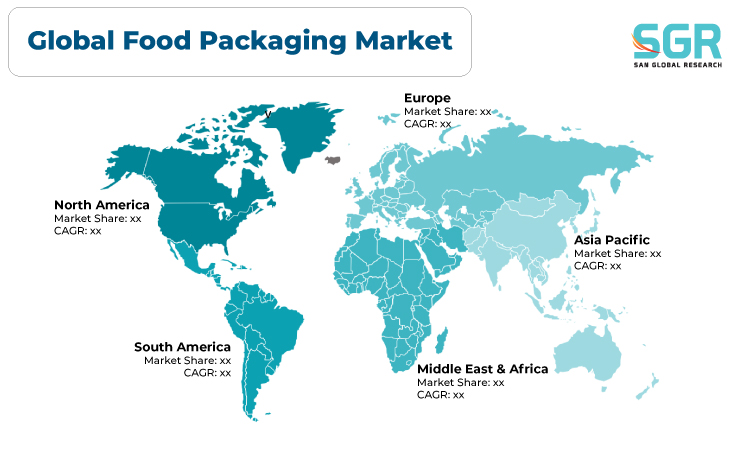
The Asia-Pacific region boasts a rapidly growing food packaging market, driven by increasing urbanization, population growth, and changing consumer preferences. Countries like China and India are witnessing a surge in demand for packaged food due to lifestyle changes and convenience. However, sustainable packaging practices are gaining traction here as well, with a rising awareness of environmental issues.
The food packaging market in Latin America reflects a mix of traditional and modern packaging solutions. While there's a growing inclination towards convenience and packaged foods, the emphasis on sustainable packaging is gradually gaining ground. Economic factors heavily influence packaging choices, and there's a noticeable shift towards more environmentally friendly options in certain regions.
The food packaging market in Africa varies significantly across different regions due to economic disparities and varying levels of industrialization. Urban areas often showcase a preference for packaged and convenience foods, whereas rural areas rely more on traditional packaging methods. Sustainable packaging initiatives are emerging, but adoption rates might differ based on accessibility and affordability.
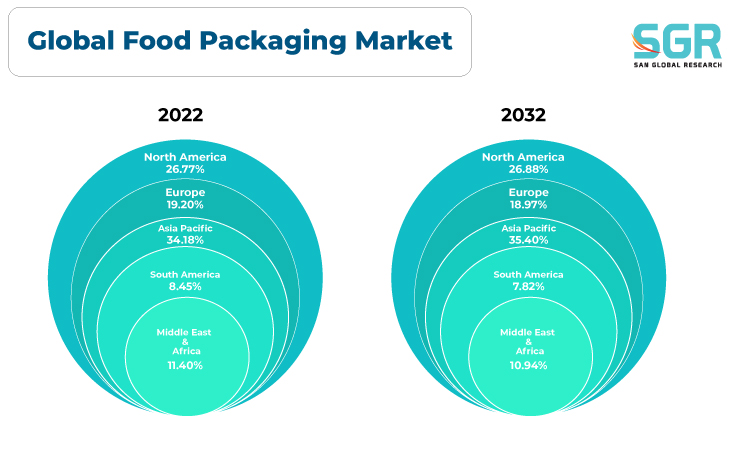
Segmentation:
The Global Food Packaging Market is segmented by type, by material, by application and region/country.
By Type:
- Based on the Type, the Global Food Packaging Market is bifurcated into Rigid, Semi Rigid & Flexible – where the Rigid is dominating and ahead in terms of share.
- This category encompasses various materials like glass, metals, and rigid plastics, delivering robust shielding and structural integrity to a diverse range of food products. Glass containers, celebrated for their inert nature and impermeability, excel in preserving flavors and maintaining food quality. Metal packaging, such as aluminum cans, provides unparalleled strength, protection from light, air, and moisture, ensuring prolonged shelf life for items like beverages and canned goods. Rigid plastics, including PET (polyethylene terephthalate) and HDPE (high-density polyethylene), offer versatility, durability, and transparency, catering to a wide array of products from dairy to condiments. The rigid nature of these packaging types not only shields contents from external contaminants but also contributes to ease of handling, stacking, and transportation throughout the supply chain.
By Material:
- Based on the Material, the Global Food Packaging Market is bifurcated into Paper, Plastic, Glass, Metal & Others – where Plastic is dominating and ahead in terms of share.
By Application:
- Based on the Application, the Global Food Packaging Market is bifurcated into Bakery & Confectionary, Dairy, Fruits & Vegetables, Meat Poultry & Sea Food, Sauces & Dressings and Others – where the Bakery & Confectionary is dominating and ahead of others in terms of share.
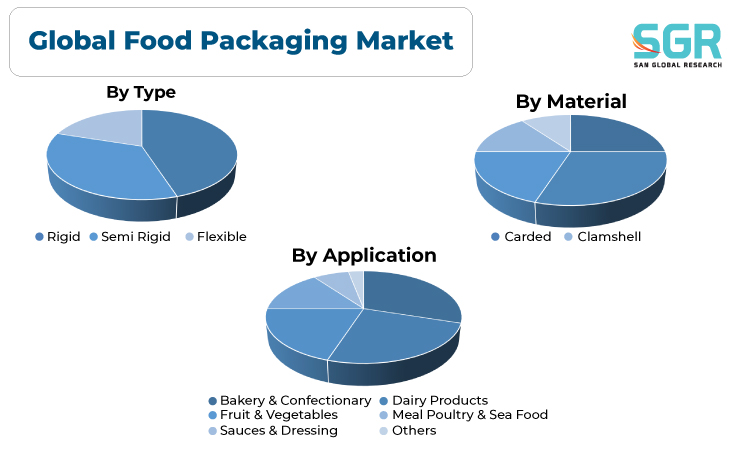
On the basis of region
- North America
- Europe
- Asia Pacific
- South America and
- Middle East and Africa
In 2022, North America is anticipated to dominate the Global Reverse Factoring Market with market revenue of XX USD Million with a registered CAGR of XX%.
Key Players:
The key market players operating in the Global Food Packaging Market include
- AMCOR
- SONOCO PRODUCTS
- BERRY GLOBAL
- WEST ROCK
- GENPAK
- WINPAK
- ALPHA
- PACMOORE
- PAKTECH
- EMMERSON
Drivers:
Growing sector across the globe
The global food packaging market is propelled by an array of dynamic drivers that continuously shape its evolution and growth trajectory. One of the primary drivers is the shifting consumer lifestyle, characterized by increasing demand for convenience and on-the-go food products, prompting innovations in packaging designs and formats. Additionally, the burgeoning population, particularly in urban areas, has amplified the need for packaged and processed foods, intensifying the demand for efficient and sustainable packaging solutions. Advancements in technology play a pivotal role, facilitating the development of intelligent packaging with features like freshness indicators and smart labels, enhancing food safety and quality. Heightened awareness and concerns regarding food safety and hygiene have also driven the adoption of innovative packaging materials and techniques aimed at prolonging shelf life and minimizing contamination risks. Moreover, stringent regulations and initiatives promoting sustainable packaging practices, such as reducing single-use plastics and promoting recyclable or biodegradable materials, have significantly influenced the industry's direction. These multifaceted drivers collectively contribute to the vibrant and ever-evolving landscape of the global food packaging market, fostering innovation, sustainability, and consumer-centric solutions.
Opportunity:
Evolving Market
The global food packaging market presents a landscape brimming with diverse opportunities spurred by technological advancements, shifting consumer preferences, and evolving market dynamics. One significant opportunity lies in the realm of sustainable packaging solutions, where the demand for eco-friendly materials and practices continues to soar. Innovations focusing on biodegradable, compostable, and recyclable packaging materials offer immense potential for market growth, aligning with the increasing emphasis on environmental consciousness and regulatory pressures to reduce plastic waste. Moreover, the integration of smart packaging technologies, such as IoT-enabled sensors and QR codes, presents another avenue for advancement. These technologies enable real-time monitoring of food freshness, traceability, and engagement with consumers, thereby enhancing convenience, safety, and transparency. Furthermore, customization and personalization trends in packaging, driven by consumer preferences for individualized experiences, open doors for tailored packaging designs and formats, cater to diverse demographics and niche markets. The burgeoning e-commerce sector also offers a significant opportunity for innovation in packaging, with a focus on creating solutions that ensure product integrity, durability during transportation, and an enhanced unboxing experience.
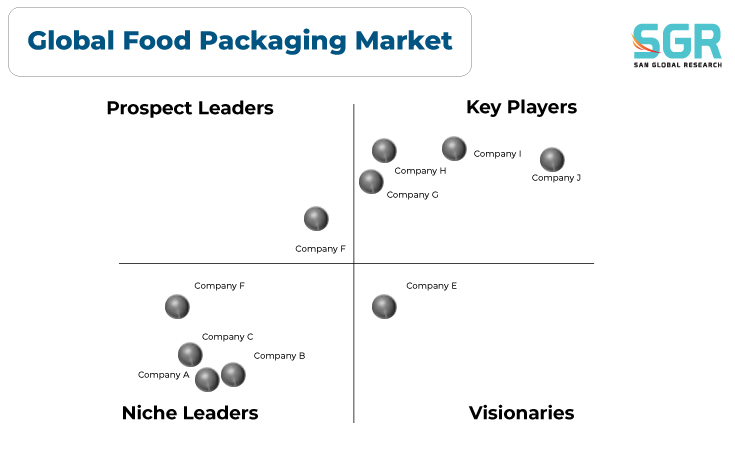

 Description
Description
 Gera Imperium Rise,
Gera Imperium Rise,  +91 9209275355
+91 9209275355


